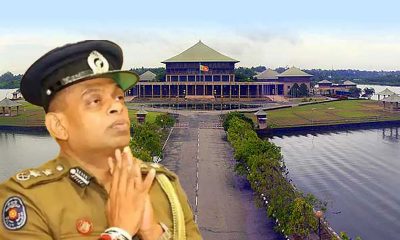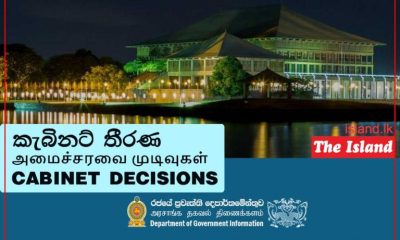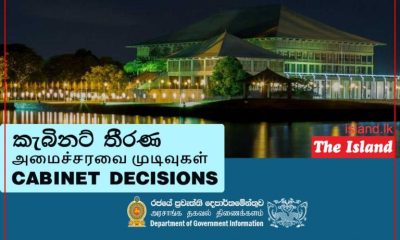Features
PLANES OF EXISTENCE

(from THE BUDDHA AND HIS TEACHINGS by Venerable Narada Mahathera)
“Not to be reached by going is world’s end.” ANGUTTARA NIKAYA
According to Buddhism the earth, an almost insignificant speck in the universe, is not the only habitable world, and humans are not the only living beings. Indefinite are world systems and so are living beings. Nor is “the impregnated ovum the only route to rebirth.” By traversing one cannot reach the end of the world, says the Buddha.
Births may take place in different spheres of existence. There are altogether thirty-one places in which beings manifest themselves according to their moral or immoral Kamma.
There are four states of unhappiness (Apaya) which are viewed both as mental states and as places.
They are:
1. Niraya (ni + aya = devoid of happiness) woeful states where beings atone for their evil Kamma. They are not eternal hells where beings are subject to endless suffering. Upon the exhaustion of the evil Kamma there is a possibility for beings born in such states to be reborn in blissful states as the result of their past good actions.
2. Tiracchana-yoni (tiro = across; acchana = going), the animal kingdom. Buddhist belief is that beings are born as animals on account of evil Kamma. There is, however, the possibility for animals to be born as human beings as a result of the good Kamma accumulated in the past. Strictly speaking, it should be more correct to state that Kamma which manifested itself in the form of a human being, may manifest itself in the form of an animal or vice versa, just as an electric current can be manifested in the forms of light, heat and motion successively — one not necessarily being evolved from the other.
It may be remarked that at times certain animals particularly dogs and cats, live a more comfortable life than even some human beings due to their past good Kamma.
It is one’s Kamma that determines the nature or one’s material form which varies according to the skilfulness or unskilfulness of one’s actions.
3. Peta-yoni (pa + ita) lit., departed beings, or those absolutely devoid of happiness. They are not disembodied spirits of ghosts. They possess deformed physical forms of varying magnitude, generally invisible to the naked eye. They have no planes of their own, but live in forests, dirty surroundings, etc. There is a special book, called Petavatthu, which exclusively deals with the stories of these unfortunate beings. Samyutta Nikaya also relates some interesting accounts of these Petas.
Describing the pathetic state of a Peta, the Venerable Moggallana says:
“Just now as I was descending Vultures’ Peak Hill, I saw a skeleton going through the air, and vultures, crows, and falcons kept flying after it, pecking at its ribs, pulling apart while it uttered cries of pain. To me, friend, came this thought: O but this is wonderful! O but this is marvellous that a person will come to have such a shape, that the individuality acquired will come to have such a shape.”
“This being,” the Buddha remarked, “was a cattle-butcher in his previous birth, and as the result of his past Kamma he was born in such a state. “
According to the Questions of Milinda there are four kinds of Petas — namely, the Vantasikas who feed on vomit, the Khuppipāsino who hunger and thirst, the Nijjhamatanhikaā, who are consumed by thirst, and the Paradattapajavino who live on the gifts of others.
As stated in the Tirokudda Sutta these last mentioned Petas share the merit performed by their living relatives in their names, and could thereby pass on to better states of happiness.
4. Asura-yoni — the place of the Asura-demons. Asura, literally, means those who do not shine or those who do not sport. They are also another class of unhappy beings similar to the Petas. They should be distinguished from the Asuras who are opposed to the Devas.
Next to these four unhappy states (Duggati) are the seven happy states (Sugati). They are:
1. Manussa — The Realm of human beings.
The human realm is a mixture of both pain and happiness. Bodhisattas prefer the human realm as it is the best field to serve the world and perfect the requisites of Buddhahood. Buddhas are always born as human beings.
2. Catummaharajika — the lowest of the heavenly realms where the Guardian Deities of the four quarters of the firmament reside with their followers.
3. Tavatimsa — lit., thirty-three — the Celestial Realm of the thirty-three Devas where Deva Sakka is the King. The origin of the name is attributed to a story which states that thirty-three selfless volunteers led by Magha (another name for Sakka), having performed charitable deeds, were born in this heavenly realm. It was in this heaven that the Buddha taught the Abhidhamma to the Devas for three months.
4. Yama — “The Realm of the Yama Devas.” That which destroys pain is Yāma.
5. Tusita — lit., happy dwellers, is “The Realm of Delight.”
The Bodhisattas who have perfected the requisites of Buddhahood reside in this Plane until the opportune moment comes for them to appear in the human realm to attain Buddhahood. The Bodhisatta Metteyya, the future Buddha, is at present residing in this realm awaiting the right opportunity to be born as a human being and become a Buddha. The Bodhisatta’s mother, after death, was born in this realm as a Deva (god). From here he repaired to Tavatimsa Heaven to listen to the Abhidhamma taught by the Buddha.
6. Nimmanarati — “The Realm of the Devas who delight in the created mansions.”
7. Paranimmitavasavatti — “The Realm of the Devas who make others’ creation serve their own ends.”
The last six are the realms of the Devas whose physical forms are more subtle and refined than those of human beings and are imperceptible to the naked eye. These celestial beings too are subject to death as all mortals are. In some respects, such as their constitution, habitat, and food they excel humans, but do not as a rule transcend them in wisdom. They have spontaneous births, appearing like youths and maidens of fifteen or sixteen years of age.
These six Celestial Planes are temporary blissful abodes where beings are supposed to live enjoying fleeting pleasures of sense.
The four unhappy states (Duggati) and the seven happy states (Sugati) are collectively termed Kamaloka — Sentient Sphere.
Superior to these Sensuous Planes are the Brahma Realms or Rupaloka (Realms of Form) where beings delight in jhanic bliss, achieved by renouncing sense-desires.
Rupaloka
consists of sixteen realms according to the jhānas or ecstasies cultivated. They are as follows:
(a) T’he Plane of the First Jhana;
1. Brahma Parisajja –– The Realm of the Brahma‘s Retinue.
2. Brahma Purohita — The Realm of the Brahma’s Ministers.
3. Mahaā Brahma — The Realm of the Great Brahmas.
The highest of the first three is Mahaā Brahma. It is so called because the dwellers in this Realm excel others in happiness, beauty, and age-limit owing to the intrinsic merit of their mental development.
(b) The Plane of the Second Jhāna:
4. Parittābhā — The Realm of Minor Lustre,
5. Appamānābhā — The Realm of Infinite Lustre,
6. Ābhassarā —
The Realm of the Radiant Brahmas.
(c) The Plane of the Third Jhāna:
7. Parittasubha — The Realm of the Brahmas of Minor Aura.
8. Appamānasubha — The Realm of the Brahmas of Infinite Aura.
9. Subhakinhaā — The Realm of the Brahmas of Steady Aura.
(d) The Plane of the Fourth Jhana:
10. Vehapphala — The Realm of the Brahmas of Great Reward.
11. Asaatta — The Realm of Mindless Beings,
12. Suddhavasa — The Pure Abodes which are further subdivided into five, viz:
i. Aviha — The Durable Realm,
ii. Atappa — The Serene Realm,
iii. Sudassa — The Beautiful Realm,
iv. Sudassi — The Clear-Sighted Realm.
v. Akanittha — the Highest Realm.
Only those who have cultivated the Jhanas or Ecstasies are born on these higher planes. Those who have developed the First Jhana are born in the first Plane; those who have developed the Second and Third Jhanas are born in the second Plane; those who have developed the Fourth and Fifth Jhanas are born in the third and fourth Planes respectively.
The first grade of each plane is assigned to those who have developed the Jhanas to an ordinary degree, the second to those who have developed the Jhanas to a greater extent, and the third to those who have gained a complete mastery over the Jhanas.
In the eleventh plane, called the Asaatta, beings are born without a consciousness.
Here only a material flux exists. Mind is temporarily suspended while the force of the Jhāna lasts. Normally both mind and matter are inseparable. By the power of meditation, it is possible, at times, to separate matter from mind as in this particular case. When an Arahant attains the Nirodha Samāpatti, too, his consciousness ceases to exist temporarily. Such a state is almost inconceivable to us. But there may be inconceivable things which are actual facts.
The Suddhavasas or Pure Abodes are the exclusive Planes of Anagamis or Never-Returners. Ordinary beings are not born in these states. Those who attain Anāgāmi in other planes are reborn in these Pure Abodes. Later, they attain Arahantship and live in those planes until their life-term ends.
There are four other planes called Arupaloka which are totally devoid of matter or bodies. Buddhists maintain that there are realms where mind alone exists without matter. “Just as it is possible for an iron bar to be suspended in the air because it has been flung there, and it remains as long as it retains any unexpended momentum, even so the Formless being appears through being flung into that state by powerful mind-force, there it remains till that momentum is expended. This is a temporary separation of mind and matter, which normally co-exist. “
It should be mentioned that there is no sex distinction in the Rupaloka and the Arupaloka.
The Arupaloka is divided into four planes according to the four Arupa Jhanas.
They are:
1. The Sphere of the Conception of Infinite Space.
2. The Sphere of the Conception of Infinite Consciousness.
3. The Sphere of the Conception of Nothingness.
4. The Sphere of Neither Perception nor Non-Perception.
It should be remarked that the Buddha did not attempt to expound any cosmological theory.
The essence of the Buddha’s teaching is not affected by the existence or non-existence of these planes. No one is bound to believe anything if it does not appeal to his reason. Nor is it proper to reject anything because it cannot be conceived by one’s limited knowledge.
Features
‘Silent Majority’ abandoned to Long-suffering in regional conflicts

 With reports emerging that India has attacked some ‘sites’ in Pakistan and Pakistan-administered Kashmir, the question could be posed whether the stage has just been set for yet another costly India-Pakistan military conflict. Sensible opinion in South Asia could only hope that wise counsel would sooner rather than later come to prevail on both sides of the divide and that they would draw back from the brink of full-scale war.
With reports emerging that India has attacked some ‘sites’ in Pakistan and Pakistan-administered Kashmir, the question could be posed whether the stage has just been set for yet another costly India-Pakistan military conflict. Sensible opinion in South Asia could only hope that wise counsel would sooner rather than later come to prevail on both sides of the divide and that they would draw back from the brink of full-scale war.
The states concerned ought to know fully well the possible wide-ranging weighty consequences of another regional conflict. It should be plain to see that it would benefit none in the two theatres of confrontation, most particularly the relevant publics or the ‘Silent Majority’.
In fact, in connection with the mentioned initial military attacks, the Pakistani side has gone on record that some civilian lives have been lost. Such losses could burgeon in the event of full scale hostilities. These costs could of course be staggering and unimaginable in the event the nuclear option is resorted to by the sides, going forward.
Accordingly, the hope of the peace-loving world-wide is likely to be that India and Pakistan would give negotiations a chance and resolve their differences peacefully. It would be in the best interests of the world for the champions of peace to join their voices to that of UN chief Antonio Guterres and call on the sides to negotiate an end to their differences.
The utter helplessness and misery of the people of the Gaza ought to drive home afresh the horrors of war. Currently the news is that the Gazans are literally starving to death. Food and other essentials provided by UN agencies are reportedly being prevented by Israel from getting to the hapless people of Gaza. So dire is their situation that concerned quarters are calling on the compassionate worldwide to provide the Gazans with food, water and other essentials voluntarily. This SOS would need to be heeded forthwith.
Accordingly, it could be inferred that most formal arrangements, including those that are generally under the purview of the UN, geared to providing emergency humanitarian assistance to the needy, have, for all intents and purposes, been rendered ineffective in the Gaza. The UN cannot be faulted for this state of things; rather, Israel should be held accountable in the main for it.
The matter of accountability is central to the dramatic slide into lawlessness the world has been experiencing over the past few decades. As could be seen, International Law is no longer fully applicable in the conflict and war zones of the world because it is not being adhered to by many state and non-state aggressors. That the UN is hapless in the face of such lawlessness is plain to see.
We have of course the Middle East wherein International Law has fallen silent for quite a while. How could it be otherwise, when Israeli aggressions are being winked at by the US, for which the policy of backing Israel is almost sacrosanct?
Moreover, under President Donald Trump, it is difficult to see the US changing policy course on the Middle East. Trump made vague promises of bringing peace to the region in the run-up to his reelection but has done nothing concrete by way of peace-making. Consequently, complete lawlessness prevails in the Middle East. US policy towards Israel counts as another example of how the self- interest of US central administrations blinds them to their international obligations, in this case Middle East peace.
However, the commentator could be criticized as being biased if he holds only Israel responsible for what has befallen the Middle East. It has been the position of this columnist that Israel’s security needs should be taken cognizance of by its state and non-state adversaries in the Middle East and acted upon if the basis is to be laid for a durable Middle East peace. Inasmuch as Palestinian statehood must be guaranteed, the same should be seen as applicable to Israel. The latter too enjoys the right to live in a secure state of its own, unopposed by its neighbours.
The Ukraine of today is also sad testimony to the ill consequences of powerful, aggressor states wantonly disregarding International Law and its obligations. Nothing could justify Russia in invading Ukraine and subjecting it to a condition of Longsuffering. Clearly, Ukraine’s sovereignty has been violated and such excesses go to the heart of the current state of ‘International Disorder’. Of course the same stricture applies to the US in relation to its military misadventures in Afghanistan and Iraq, to name just two such modern examples.
There is no ducking the fact, then, that civilian publics in the mentioned theatres of war and outside, are being subjected to the worst suffering as a consequence of the big powers’ self-aggrandizement schemes and military misadventures. Longsuffering becomes the tragic lot of the people who have nothing to do with such unbridled power ambitions.
One would not be exaggerating the case if he states that civilian publics count for almost nothing in the present ‘International Disorder’. Increasingly it is becoming evident that from the viewpoint of the big powers and authoritarian governments the people are of little or no importance. Considering that self-aggrandizement is of the paramount interest for the former the public interest is coming to be seen as inconsequential.
Consequently, not much of a case could be made currently for the once almost reverentially spoken of ‘Social Contract’. For, the public interest does not count for much in the scrambles for power among the major powers who are seen at the popular level as the principal history-makers.
It is in view of the above that much is expected of India. Today the latter is a ‘Swing State’ of the first importance. Besides being a major democracy, it is one of the world’s principal economic and military powers. It possesses abundant potential to help to put things right in international politics. If there is one state in Asia that could help in restoring respect for International Law, it is India.
Considering the above, India, one believes, is obliged to bear the responsibility of keeping South Asia free of any more long-running, wasting wars that could aggravate the material hardships and socio-economic blights of the region. Thus, India would need to consider it imperative to negotiating peace with Pakistan.
Features
Memorable happening … Down Under

 Under the Global-Ise Australia Advanced Sports Development Programme, a delegation of 15 swimmers from Lyceum International School, Wattala, had the remarkable opportunity to train and experience high-performance sports development in Melbourne, Australia.
Under the Global-Ise Australia Advanced Sports Development Programme, a delegation of 15 swimmers from Lyceum International School, Wattala, had the remarkable opportunity to train and experience high-performance sports development in Melbourne, Australia.
The 10-day programme was carefully curated to offer intensive training, educational exposure, and cultural experiences for the young athletes.
The swimmers underwent specialised training through Swimming Victoria’s elite programme, held at some of Melbourne’s premier aquatic facilities.

Visit to Victorian Parliament
Each day began as early as 5:00 a.m. and continued until 7:00 p.m., ensuring a rigorous and enriching schedule that mirrored the standards of international competitive swimming.
Beyond training, the programme offered a wide array of experiences to broaden the students’ horizons.

Morning training
The tour group explored iconic landmarks such as the Victorian Parliament and the Melbourne Cricket Ground (MCG), and enjoyed shopping at Chadstone – The Fashion Capital. They also experienced the natural beauty of Victoria with visits to Yarra Valley Chocolaterie & Ice Creamery, and Cardinia Reservoir Park, where they observed kangaroos in their natural habitat.
An academic highlight of the tour was the group’s exclusive visits to three of Australia’s leading universities: the University of Melbourne, Monash University, and Deakin University. These visits aimed to inspire students and showcase the vast educational opportunities available in Australia.

Checking out the scene at Yarra Valley Chocolaterie & Ice Creamery
As part of the cultural immersion, Global-Ise hosted a traditional Australian BBQ at the Tim Neville Arboretum in Ferntree Gully. The students also enjoyed a variety of diverse culinary experiences each evening, further enriching their understanding of local and international food cultures.
The tour concluded with a celebratory dinner at the Spicy Wicket Restaurant, where each participant received a presentation in recognition of their involvement.

Enjoying an Aussie BBQ for lunch
The evening was made especially memorable by the presence of Pradeepa Saram, Consul General of Sri Lanka in Victoria.
Global-Ise Management—Ken Jacobs, Johann Jayasinha, and Dr Luckmika Perera (Consultant from the University of Melbourne)—did a magnificent job in planning and the execution of the advanced sports programme.

Coaches from Sri Lanka presenting a plaque to Global-Ise Management team
Ken Jacobs (centre), Johann Jayasinha, and Dr Luckmika Perera (on the right
Features
Bright, Smooth Skin

 Hi! How’s the beauty scene keeping with you?
Hi! How’s the beauty scene keeping with you?
Phew, this heat is awful but there is nothing that we can do about it.
However, there are ways and means to take care of your skin and I will do my best to help you in every way I can.
Well, this week, let’s go for a Bright, Smooth Skin.
Gram flour (also known as besan) is a traditional skincare ingredient known for its:
* Natural exfoliating properties.
* Ability to absorb excess oil.
* Gentle brightening and tan-removal effects.
* Suitability for all skin types, especially oily and acne-prone skin.
You will need 01–02 tablespoons gram flour (besan) and rose water, or raw milk, to make a paste.
You could add the following two as optional add-ins: A pinch of turmeric (for extra glow), and a few drops of lemon juice (for oily skin and pigmentation)
Add the gram flour to a small bowl and mix in the rose water (for oily/sensitive skin) or raw milk (for dry skin) slowly.
Stir well to make a smooth, spreadable paste—not too thick, not too runny.
Now apply this mixture, evenly, to your damp face and neck, and let it sit for 5–10 minutes (don’t let it dry completely if you have dry skin).
Gently massage in circular motions using wet fingers—this helps exfoliate.
Rinse off with lukewarm water, and then pat your skin dry.
Use it 02–03 times a week for best results.
Skin Benefits:
* Removes dirt, sweat, and oil without stripping natural moisture.
* Gently exfoliates dead skin cells, revealing smoother skin.
* Brightens the complexion and fades mild tanning.
* Helps clear clogged pores and reduce pimples.
* Leaves skin fresh and glowing—perfect for humid climates.
-

 News7 days ago
News7 days agoRanil’s Chief Security Officer transferred to KKS
-

 Opinion5 days ago
Opinion5 days agoRemembering Dr. Samuel Mathew: A Heart that Healed Countless Lives
-

 Business3 days ago
Business3 days agoAitken Spence Travels continues its leadership as the only Travelife-Certified DMC in Sri Lanka
-

 Business3 days ago
Business3 days agoLinearSix and InsureMO® expand partnership
-

 Latest News2 days ago
Latest News2 days agoNPP win Maharagama Urban Council
-

 Business7 days ago
Business7 days agoCCPI in April 2025 signals a further easing of deflationary conditions
-

 Features5 days ago
Features5 days agoTrump’s economic missiles are boomeranging
-

 Features7 days ago
Features7 days agoExpensive to die; worship fervour eclipses piety





















